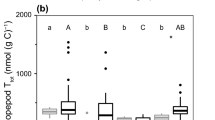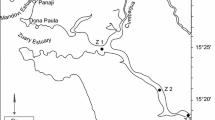Abstract
The potential toxicity of elevated selenium (Se) concentrations in aquatic ecosystems has stimulated efforts to measure Se concentrations in benthos, nekton, and waterfowl in San Francisco Bay (SF Bay). In September 1998, we initiated a 14 mo field study to determine the concentration of Se in SF Bay zooplankton, which play a major role in the Bay food web, but which have not previously been studied with respect to Se. Monthly vertical plankton tows were collected at several stations throughout SF Bay, and zooplankton were separated into two operationally defined size classes for Se analyses: 73–2,000 μm, and ≥2,000 μm. Selenium values ranged 1.02–6.07 μg Se g−1 dry weight. No spatial differences in zooplankton Se concentrations were found. However, there were inter- and intra-annual differences. Zooplankton Se concentrations were enriched in the North Bay in Fall 1999 when compared to other seasons and locations within and outside SF Bay. The abundance and biovolume of the zooplankton community varied spatially between stations, but not seasonally within each station. Smaller herbivorous-omnivorous zooplankton had higher Se concentrations than larger omnivorous-carnivorous zooplankton. Selenium concentrations in zooplankton were negatively correlated with the proportion of total copepod biovolume comprising the large carnivorous copepodTortanus dextrilobatus, but positively correlatid with the proportion of copepod biovolume comprising smaller copepods of the family Oithonidae, suggesting an important role of trophic level and size in regulating zooplankton Se concentrations.
Similar content being viewed by others
Literature Cited
Ambler, J. W., J. E. Cloern, andA. Hutchinson. 1985. Seasonal cycle of zooplankton from San Francisco Bay.Hydrobiologia 129:177–197.
Baines, S. B. andN. S. Fisher. 2001. Interspecific differences in the bioconcentration of selenite by phytoplankton and their ecological implications.Marine Ecology Progress Series 213:1–12.
Bengtsson, J., S. R. Baillie, andJ. Lawton. 1997. Community variability increases with time.Oikos 78:249–256.
Besser, J. M., T. J. Canfield, andT. W. LaPoint. 1993. Bioaccumulation of organic and inorganic selenium in a laboratory food chain.Environmental Toxicology and Chemistry 12:57–72.
Boisson, F. andM. Romeo. 1996. Selenium in plankton from the Northwestern Mediterranean Sea.Water Research 30:2593–2600.
Bollens, S. M., S. Avent, J. Cordell, W. Kimmerer, andC. Penalva-Arana. 1999. San Francisco Bay zooplankton: Interannual and interdecadal variation, with special reference to non-indigenous species and ENSO effects.EOS 80:133.
Bowie, G. L., J. G. Sanders, G. F. Riedel, C. C. Gilmour, D. L. Breitburg, G. A. Cutter, andD. B. Porcella. 1996. Assessing selenium cycling and accumulation in aquatic ecosystems.Water Air and Soil Pollution 90:93–104.
Brown-Peterson, N. J., M. S. Peterson, D. A. Rydene, andR. W. Eames. 1993. Fish assemblages in natural versus well-established recolonized seagrass meadows.Estuaries 16:177–189.
Brugmann, L. andU. Hennings. 1994. Metals in zooplankton from the Baltic Sea, 1980–84.Journal of Chemical Ecology 9:87–103.
Cloern, J. E. 1987. Turbidity as a control on phytoplankton biomass and productivity in estuaries.Continental Shelf Research 7:1367–1381.
Cloern, J. E. andF. H. Nichols. 1985. Time scales and mechanisms of estuarine variability, a synthesis from studies of San Francisco Bay.Hydrobiologia 129:229–237.
Conomos, T. J. 1979. San Francisco Bay: The urbanized estuary. Pacific Division of the American Association for the Advancement of Science, San Francisco, California.
Cumbie, P. M. andS. L. Van Horn. 1978. Selenium accumulation associated with fish mortality and reproductive failure.Proceedings of the Annual Conference of the Southeast Association Fish and Wildlife Agenices 32:612–624.
Cutter, G. A. 1978. Species determinations of selenium in natural waters.Analytica Chimica Acta 98:59–66.
Cutter, G. A. 1985. Determination of selenium speciation in biogenic particles and sediments.Analytica Chimica Acta 57: 2951–2955.
Cutter, G. A.. 1989. The estuarine behaviour of selenium in San Francisco Bay.Estuarine, Caostal and Shelf Science 28:13–34.
Cutter, G. A. andM. L. C. San Diego-McGlone. 1990. Temporal variability of selenium fluxes in San Francisco Bay.The Science of the Total Environment. 97:235–250.
Dam, H. G., C. A. Miller, andS. H. Jonasdottir. 1993. The trophic role of mesozooplankton at 47°N, 20°W during the North Atlantic Bloom Experiment.Deep-Sea Research, II 40: 197–212.
Dam, H. G., X. Zhang, M. Butler, andM. R. Roman. 1995. Mesozooplankton grazing and metabolism at the equator in the central Pacific: Implications for carbon and nitrogen fluxes.Deep-Sea Research, II 42:735–756.
Farnsworth, E. J. andA. M. Ellison. 1996. Scale-dependent spatial and temporal variability in biogeography of mangrove root epibiont communities.Ecological Monographs 66:45–66.
Fisher, N. S. andJ. R. Reinfelder. 1991. Assimilation of selenium in the marine copepodAcartia tonsa studied with a radiotracer ratio method.Marine Ecology Progress Series 70:157–164.
Fisher, N. S. andJ. R. Reinfelder. 1995. The trophic transfer of metals in marine systems, p. 363–406.In A. Tessier and D. Turner (eds.). Metal Speciation and Bioavailability in Aquatic Systems. John Wiley and Sons, New York.
Fowler, S. W. andG. Benayoun. 1976. Selenium kinetics in marine zooplankton.Marine Science Communications 2:43–67.
Garrett, G. P. andC. R. Inman. 1984. Selenium-induced changes in the fish populations of a heated reservoir.Proceedings of the Annual Conference of the Southeast Association Fish and Wildlife Agencies 38:291–301.
Ghent, A. W. 1982. Tau as an index of similarity in community comparisons: An approach permitting the hypothesis of unequal species abundance.Canadian Journal of Zoology 61:687–690.
Goede, A. A., H. Th. Wolterbeek, andM. J. Koese. 1993. Selenium concentrations in the marine invertebratesMacoma balthica, Mytilus edulis, andNereis diversicolor.Archives of Environmental Contamination and Toxicology 25:85–89.
Grossman, G. D., M. C. Freeman, P. B. Moyle, andJ. O. Whitaker. 1985. Stochasticity and assemblage organization in an Indiana stream fish assemblage.American Naturalist 126:275–285.
Harrison, P. J., P. W. Yu, P. A. Thompson, N. M. Price, andD. J. Phillips. 1988. Survey of selenium requirements in marine phytoplankton.Marine Ecology Progress Series 47:89–96.
Herbold, B. 1984. Structure of an Indiana stream fish association: Choosing an appropriate model.American Naturalist 124: 561–572.
Hu, M. H., Y. P. Yang, J. M. Martin, K. Yin, andP. J. Harrison. 1997. Preferential uptake of Se(IV) over Se(VI) and the production of dissolved organic Se by marine phytoplankton.Marine Environmental Research 44:225–231.
Johns, C. E., S. N. Luoma, andV. Elrod. 1988. Selenium accumulation in benthic bivalves and fine sediments of San Francisco Bay, the Sacramento-San Joaquin Delta, and selected tributaries.Estuarine, Coastal and Shelf Science 27:381–396.
Jumars, P. A. 1980. Rank correlation and concordance tests in community analyses: An inappropriate null hypothesis.Ecology 61:1553–1554.
Kimmerer, W. J., J. R. Burau, andW. A. Bennett. 1998. Tidally-oriented vertical migration and position maintenance of zooplankton in a temperate estuary.Limnology and Oceanography 43:1697–1709.
Kimmerer, W. J. andJ. J. Orsi. 1996. Causes of long-term declines in zooplankton in the San Francisco Bay estuary since 1987, p. 403–24.In J. T. Hollibaugh (ed.), San Francisco Bay: The Ecosystem. Pacific Division of the American Association for the Advancement of Science, San Francisco, California.
Kosta, L., V. Ravnik, A. R. Byrne, J. Stirn, M. Dermelj, andP. Stegnar. 1978. Some trace elements in the waters, marine organisms and sediments of the Adriatic by neutron activation analysis.Journal of Radioanalytical Chemistry 44:317–332.
Lemly, A. D. 1993. Guidelines for evaluating selenium data from aquatic monitoring and assessment studies.Environmental Monitoring and Assessment 28:83–100.
Lemly, A. D. 1996. Assessing the toxic threat of selenium to fish and aquatic birds.Ecotoxicology and Environmental Safety 32: 280–288.
Linville, R. G., S. N. Luoma, L. Cutter, andG. A. Cutter. 2002. Increased selenium threat as a result of invasion of the exotic bivalvePotamocorbula amurensis into the San Francisco Bay-Delta.Aquatic Toxicology 57:51–64.
Liu, D. L., Y. P. Yang, M. H. Hu, P. J. Harrison, andN. M. Price. 1987. Selenium content of marine food chain organisms from the coast of China.Marine Environmental Research 22:151–165.
Luoma, S. N. 1997. Selenium trends in North San Francisco Bay.Interagency Ecological Program for the Sacramento-San Joaquin Estuary Newsletter Spring:25–26.
Luoma, S. N., C. Johns, N. S. Fisher, N. A. Steinberg, andR. S. Oremland. 1992. Determination of selenium bioavailability to a benthic bivalve from particulate and solute pathways.Environmental Science and Technology 26:485–491.
Luoma, S. N. andD. J. H. Phillips. 1988. Distribution, variability, and impacts of trace elements in San Francisco Bay.Marine Pollution Bulletin 19:413–425.
Maier, K. J., C. G. Foe, andA. W. Knight. 1993. Comparative toxicity of selenate, selenite, seleno-DL-methionine and seleno-DL-cystine toDaphnia magna.Environmental Toxicology and Chemistry 12:755–763.
Meng, L. andJ. J. Orsi. 1991. Selective predation by larval striped bass on native and introduced copepods.Transactions of the American Fisheries Society 120:157–192.
Norusis, M. J. 1999. SPSS 9.0 Guide to Data Analysis. Prentice-Hall, Inc., New York.
Ohlendorf, H. M., D. J. Hoffman, M. K. Saiki, andT. W. Aldrich. 1986. Embryonic mortality and abnormalities of aquatic birds: Apparent impacts of selenium from irrigation drainwater.Science of the Total Environment 52:49–63.
Orsi, J. J. 1995. Radical changes in the estuary's zooplankton caused by introductions from ballast water.Interagency Ecological Program Newsletter Summer:16–17.
Orsi, J. J. andW. L. Mecum. 1986. Zooplankton distribution and abundance in the Sacramento-San Joaquin Delta in relation to certain environmental factors.Estuaries 9:326–339.
Paffenhofer, G. A. 1993. On the ecology of marine cyclopoid copepods (Crustacea, Copepoda).Journal of Plankton Research 15:37–55.
Peterson, D. H., R. E. Smith, S. W. Hager, D. D. Harmon, R. E. Herndon, andL. E. Schemel. 1985. Interannual variability in dissolved inorganic nutrients in Northern San Francisco Bay estuary.Hydrobiologia 129:37–58.
Price, N. M., P. A. Thompson, andP. J. Harrison. 1987. Selenium: An essential element for growth of the coastal marine diatomThalassiosira pseudonana (Bacillariophyceae).Journal of Applied Phycology 23:1–9.
Rahel, F. J., J. D. Lyons, andP. A. Cochran. 1984. Stochastic or deterministic regulation of assemblage structure? It may depend on how the assemblage is defined.American Naturalist 124:583–589.
Reinfelder, J. R. andN. S. Fisher. 1994. Retention of elements absorbed by juvenile fish (Menidia menidia, Menidia beryllina) from zooplankton prey.Limnology and Oceanography 39:1783–1789.
Schlekat, C. E., A. W. Decho, andG. T. Chandler. 2000. Bioavailability of particle-associated silver, cadmium, and zinc to the estuarine amphipodLeptocheirus plumulosus through dietary ingestion.Limnology and Oceanography 45:11–21.
Schlekat, C. E., B.-G. Lee, andS. N. Luoma. 2002. Dietary metals exposure and toxicity by aquatic organisms: Implications for ecological risk assessment, p. 151–188.In M. Newman (ed.), Coastal and Estuarine Risk Assessment. Lewis Publishers, Boca Raton, Florida.
Schlekat, C. E., B.-G. Lee, andS. N. Luoma. 2002. Assimilation of selenium from phytoplankton by three benthic invertebrates: Effect of phytoplankton species.Marine Ecology Progress Series 237:79–85.
Skorupa, J. P. 1998. Selenium poisoning of fish and wildlife in nature: Lessons from twelve real-world examples, p. 315–354.In W. Frankenberger and R. A. Engberg (eds.), Environmental Chemistry of Selenium. Marcel Dekker, Inc., New York.
Thomas, B. V., A. W. Knight, andK. J. Maier. 1999. Selenium bioaccumulation by the water boatmanTrichocorixa reticulata (Guerin-Meneville).Archives of Environmental Contamination and Toxicology 36:295–300.
Tolimieri, N., P. F. Sale, R. S. Nemeth, andK. B. Gestring. 1998. Replenishment of populations of Caribbean reef fishes: Are spatial patterns of recruitment consistent through time?Journal of Experimental Marine Biology and Ecology 230:55–71.
Turner, S. J., S. F. Thrush, R. D. Pridmore, J. E. Hewitt, V. J. Cummings, andM. Maskery. 1995. Are soft-sediment communities stable? An example from a windy harbour.Marine Ecology Progress Series 120:219–230.
Urquhart, K. A. F. andK. Regalado. 1991. Selenium Verification Study: 1988–1990. Water Resources Control Report 91-2-WQ. State Water Resources Control Board, Sacramento, California.
Walters, R. A., R. T. Cheng, andT. J. Conomos. 1985. Time scales of circulation and mixing processes of San Francisco Bay waters.Hydrobiologia 129:13–36.
Wang, W.-X. andN. S. Fisher. 1998. Accumulation of trace elements in a marine copepod.Limnology and Oceanography 43: 273–283.
White, J. R., P. S. Hoffman, D. Hammond, andS. Baumgartner. 1988. Selenium Verification Study: 1986–1987. Water Resources Control Report. State Water Resources Control Board, Sacramento, California.
Wrench, J. J. 1978. Selenium metabolism in the marine phytoplanktersTetraselmis tetathele andDunaliella minuta.Marine Biology 49:231–236.
Sources of unpublished materials
Schlekat, C. unpublished data. U.S. Borax Inc., 26877 Tourney Road, Valencia, California 91355.
Stewart, R. unpublished data. U.S. Geological Survey, 345 Middlefield Road, Menlo Park, California 94025.
Author information
Authors and Affiliations
Corresponding author
Rights and permissions
About this article
Cite this article
Purkerson, D.G., Doblin, M.A., Bollens, S.M. et al. Selenium in San Francisco Bay zooplankton: Potential effects of hydrodynamics and food web interactions. Estuaries 26, 956–969 (2003). https://doi.org/10.1007/BF02803354
Received:
Revised:
Accepted:
Issue Date:
DOI: https://doi.org/10.1007/BF02803354




